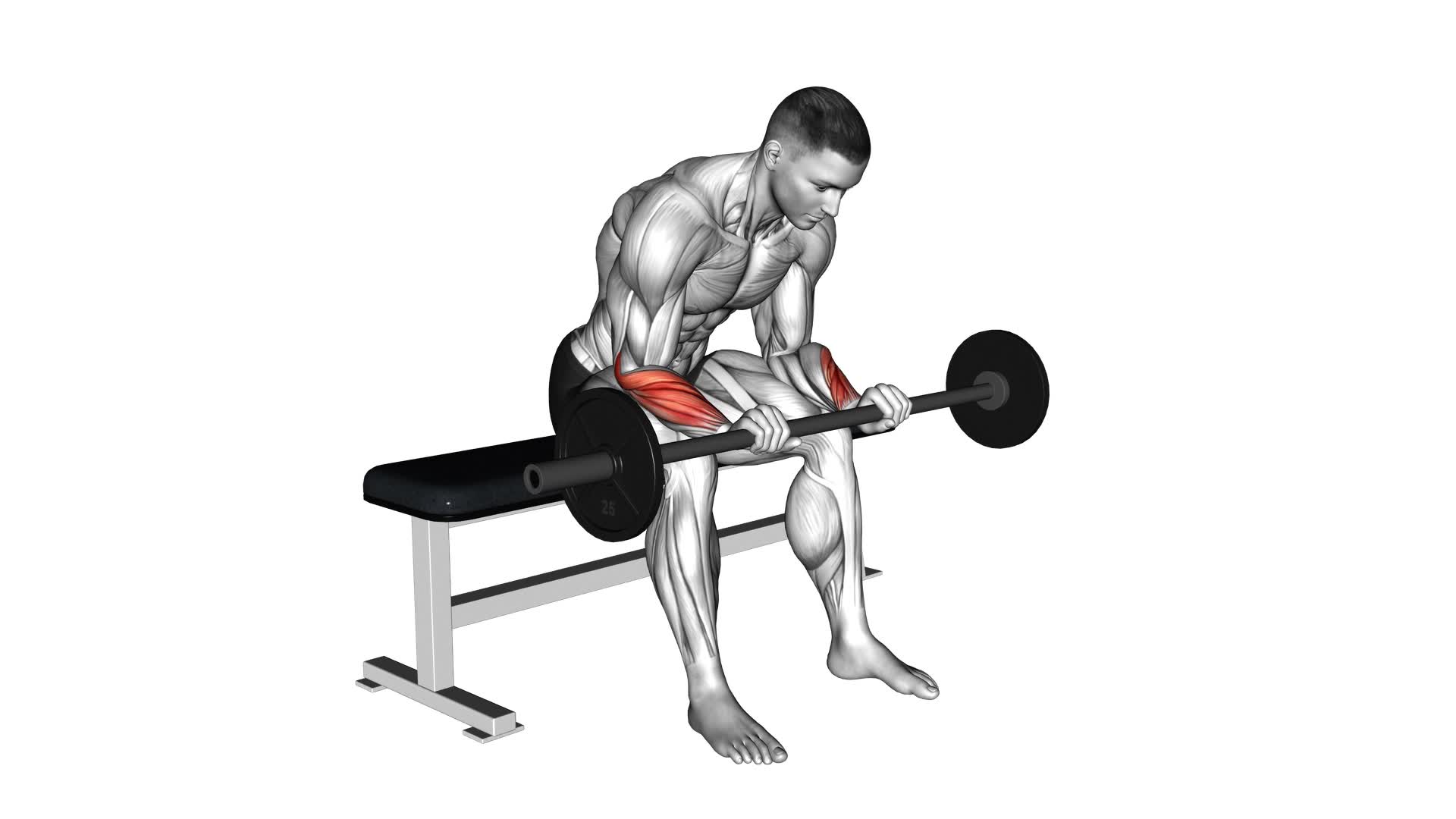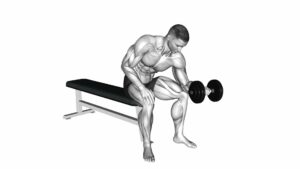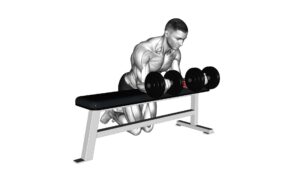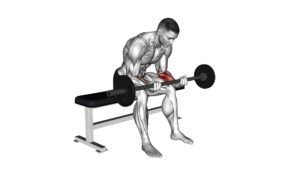Barbell Revers Wrist Curl (VERSION 2) – Video Exercise Guide & Tips

Are you looking to strengthen your wrists and forearms?
Watch This Exercise Video
Then the barbell reverse wrist curl is the exercise for you!
In this video exercise guide, we'll show you the proper form and technique for this effective exercise.
You'll also learn helpful tips for maximizing your results and avoiding common mistakes.
Get ready to boost your wrist strength and improve your overall performance with the barbell reverse wrist curl!
Key Takeaways
- Barbell Reverse Wrist Curl is essential for improving wrist strength and stability.
- It plays a vital role in overall fitness and performance, benefiting exercises like push-ups, pull-ups, and weightlifting.
- The exercise enhances performance, prevents injuries, and improves grip strength for everyday tasks.
- To maximize results, focus on proper form and technique, gradually increase resistance, and incorporate alternative exercises to prevent plateaus.
Benefits of Barbell Reverse Wrist Curl
You will experience significant improvements in your wrist strength and stability by incorporating barbell reverse wrist curls into your workout routine. Wrist strength is often overlooked, but it's crucial for overall fitness. Your wrists play a vital role in many exercises, such as push-ups, pull-ups, and weightlifting. Strong wrists not only enhance your performance but also help prevent injuries.
Integrating wrist exercises into your workout routine is essential for several reasons. First, it allows you to build strength and endurance specifically in your wrists, which can improve your overall strength and stability. This is particularly beneficial for athletes and individuals who engage in activities that require repetitive wrist movements, such as tennis, golf, or boxing.
Second, wrist exercises can help prevent common injuries, such as sprains and strains. Strong wrists are less likely to give out under pressure, reducing the risk of accidents during physical activities.
Lastly, incorporating wrist exercises into your routine can enhance your grip strength. A strong grip isn't only important for lifting weights but also for performing everyday tasks like carrying groceries or opening jars.
Proper Form and Technique for Barbell Reverse Wrist Curl
To perform the barbell reverse wrist curl with proper form and technique, start by positioning yourself behind a flat bench. Grip the barbell by grabbing it with an overhand grip, slightly wider than shoulder-width apart. Your palms should be facing downward, away from your body.
Sit on the edge of the bench and place your forearms on your thighs, with your wrists hanging off the edge. Ensure that your forearms are fully supported.
Keeping your forearms flat on your thighs, curl the barbell upward by flexing your wrists. Focus on using your forearm muscles to lift the weight. Hold the top position for a brief moment, squeezing your forearms.
This exercise is excellent for wrist strengthening and targeting the muscles in your forearms. It can be done as part of your wrist strengthening exercises routine or as an alternative to traditional wrist curl exercises. Remember to start with a lighter weight to master the proper form and gradually increase the weight as you get stronger.
Now that you know the proper form and technique for the barbell reverse wrist curl, let's move on to discussing variations and modifications for this exercise.
Variations and Modifications for Barbell Reverse Wrist Curl
To add variety to your wrist strengthening routine, consider incorporating different variations and modifications of the barbell reverse wrist curl exercise. By using different equipment options, you can target your wrist muscles in different ways and challenge them in new and effective ways.
One option is to use a dumbbell instead of a barbell. This allows for a greater range of motion and can help improve grip strength.
Another option is to use a wrist roller, which involves holding onto a weighted cylinder and rolling it up and down with your wrists. This exercise puts more emphasis on forearm muscles and can help improve wrist stability.
In addition to different equipment options, there are also progression strategies that can be used to gradually increase the difficulty of the reverse wrist curl exercise.
One strategy is to increase the weight being lifted. Start with a lighter weight and gradually add more weight as your strength improves.
Another strategy is to increase the number of repetitions or sets. Start with a lower number and gradually increase over time.
Finally, you can also increase the tempo of the exercise, either by performing the exercise faster or by pausing at the top or bottom of the movement for longer periods of time.
These progression strategies can help you continue to challenge your wrist muscles and make progress in your wrist strengthening routine.
Tips for Maximizing Results With Barbell Reverse Wrist Curl
To maximize your results with the barbell reverse wrist curl, focus on maintaining proper form and gradually increasing the resistance. Here are three tips to help you maximize gains with this exercise:
- Use a controlled motion: When performing the barbell reverse wrist curl, it's important to maintain control throughout the movement. Avoid using momentum or swinging the barbell, as this can take away from the targeted muscle engagement. Instead, focus on a slow and deliberate motion, squeezing your forearms and wrists as you lift the weight.
- Gradually increase the resistance: As you become more comfortable with the exercise, gradually increase the weight to continue challenging your muscles. However, be sure to increase the resistance in small increments to avoid overloading your wrists and forearms. This progressive overload will help stimulate muscle growth and improve strength over time.
- Try alternative exercises: While the barbell reverse wrist curl is an effective exercise, it's always beneficial to incorporate variety into your workouts. Consider adding other exercises that target the same muscles, such as dumbbell wrist curls, hammer curls, or reverse grip barbell curls. These alternative exercises can help prevent plateaus and keep your workouts fresh.
Common Mistakes to Avoid During Barbell Reverse Wrist Curl
To avoid common mistakes during the barbell reverse wrist curl, it's important to consistently practice proper form and technique.
One common mistake to avoid is incorrect wrist position. Many people tend to flex or extend their wrists too much during this exercise, which can put unnecessary strain on the joint and increase the risk of injury. To maintain proper wrist position, make sure your wrists are in a neutral position throughout the movement. This means keeping them in a straight line with your forearms, neither flexing nor extending them.
Another mistake to avoid is using too much weight. While it may be tempting to load up the barbell, using excessive weight can compromise your form and put excessive strain on your wrists and forearms. Start with a lighter weight and gradually increase as you build strength and confidence.
Lastly, rushing through the exercise is another common mistake. Take your time and perform each rep with control and precision, focusing on the contraction of the muscles in your wrists and forearms.
Frequently Asked Questions
How Many Sets and Reps Should I Do for the Barbell Reverse Wrist Curl?
For the barbell reverse wrist curl, the number of sets and reps you should do depends on your fitness goals and current fitness level.
It's generally recommended to start with 2-3 sets of 8-12 reps.
However, you can vary the sets and reps to challenge your muscles and prevent plateau.
Remember to use proper form and gradually increase the weight as you get stronger.
Consulting with a fitness professional can help you tailor the sets and reps to your specific needs.
Can I Use Dumbbells Instead of a Barbell for the Reverse Wrist Curl?
Yes, you can definitely use dumbbells instead of a barbell for the reverse wrist curl. This exercise has a few dumbbell variations that you can try.
Using dumbbells allows for a greater range of motion and gives you more control over the movement. The reverse wrist curl targets your forearm muscles and helps improve wrist strength and flexibility.
Incorporating dumbbells in your workout routine can provide added variety and challenge to your training.
Is It Necessary to Use a Wrist Strap or Support During the Exercise?
Using wrist straps or supports during wrist exercises can provide several benefits. They can help to stabilize your wrists and prevent excessive strain or injury.
However, when performing the barbell reverse wrist curl exercise, it isn't necessary to use a wrist strap or support. This exercise primarily targets the forearm muscles and doesn't put a significant amount of stress on the wrists.
You can also try variations of the barbell reverse wrist curl exercise to target different muscles.
Should I Perform the Barbell Reverse Wrist Curl With an Overhand or Underhand Grip?
To perform the barbell reverse wrist curl, you have the option to use either an overhand or underhand grip. Both grips target different muscles in your forearms and wrists.
With an overhand grip, you engage the extensor muscles on the top of your forearm.
An underhand grip targets the flexor muscles on the bottom of your forearm.
Choose the grip that aligns with your specific goals and preferences. Experiment with both to see which grip feels more effective for you.
Can the Barbell Reverse Wrist Curl Help With Wrist Pain or Injury Rehabilitation?
The barbell reverse wrist curl can be an effective exercise for wrist pain relief and injury rehabilitation. By targeting the muscles and tendons in your wrists, this exercise can help strengthen them and improve their overall flexibility.
Incorporating wrist strengthening exercises like the barbell reverse wrist curl into your routine can assist in reducing pain and promoting healing. Remember to consult with a healthcare professional before starting any new exercise program, especially if you have a pre-existing injury.
Conclusion
In conclusion, the barbell reverse wrist curl is a beneficial exercise for strengthening the muscles in the forearms and wrists.
By maintaining proper form and technique, variations and modifications can be made to target specific areas.
To maximize results, it's important to focus on the mind-muscle connection and avoid common mistakes.
Incorporating this exercise into your workout routine can help improve grip strength and overall upper body strength.

Author
Years ago, the spark of my life’s passion ignited in my mind the moment I stepped into the local gym for the first time. The inaugural bead of perspiration, the initial endeavor, the very first surge of endorphins, and a sense of pride that washed over me post-workout marked the beginning of my deep-seated interest in strength sports, fitness, and sports nutrition. This very curiosity blossomed rapidly into a profound fascination, propelling me to earn a Master’s degree in Physical Education from the Academy of Physical Education in Krakow, followed by a Sports Manager diploma from the Jagiellonian University. My journey of growth led me to gain more specialized qualifications, such as being a certified personal trainer with a focus on sports dietetics, a lifeguard, and an instructor for wellness and corrective gymnastics. Theoretical knowledge paired seamlessly with practical experience, reinforcing my belief that the transformation of individuals under my guidance was also a reflection of my personal growth. This belief holds true even today. Each day, I strive to push the boundaries and explore new realms. These realms gently elevate me to greater heights. The unique combination of passion for my field and the continuous quest for growth fuels my drive to break new ground.







